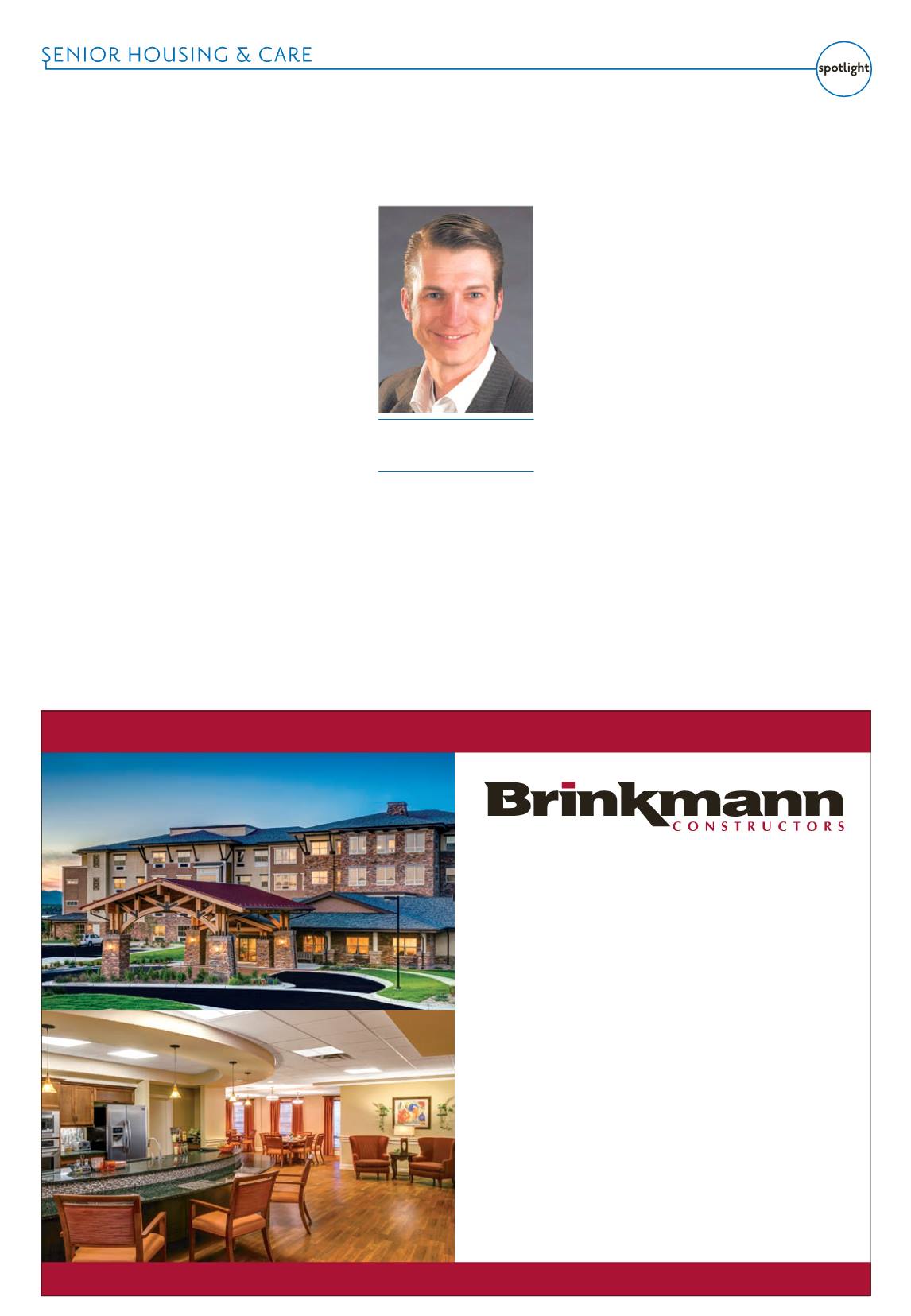
Page 4B—
COLORADO REAL ESTATE JOURNAL
—
April 20-May 3, 2016
P R O U D B U I L D E R S O F
WIND CREST
H i g h l a n d s R a n c h , C O
Mill Vista Lodge at Wind Crest
integrates short-term rehab,
skilled nursing, assisted living and memory care services into
one facility along with amenity spaces including a theater,
salon, spas and a rooftop patio. The project utilized a unique
structural system which presented the team with coordination
and scheduling challenges.
Brinkmann Constructors solved this intricate puzzle with many
pieces by developing a detailed phasing schedule and sequencing
plan all while meeting an aggressive 12 month schedule.
SOLVED AN INTRICATE PUZZLE WITH MANY PIECES
3855 Lewiston Street, Suite 100
Aurora, CO 80011
Tel (303) 657-9700
A
s more baby boomers
reach retirement age,
demand has grown
for affordable housing that
accommodates their needs.
Recent studies have shown
that aging residents wish to
remain independent and in
their own homes as long as they
can. Unfortunately, that isn’t
always an option. Critical design
issues often make it difficult or
impossible to stay in their current
space as mobility, strength,
balance and other capacities
decline.
Enterprise Green
Communities, an organization
dedicated to providing
information on how to build,
rehabilitate and operate
affordable, healthy and energy-
efficient homes, identified a
need for a set of aging-in-place
guiding principles. The goal
was to help pinpoint design
features that, if incorporated
into new construction and/or
existing buildings, would give
seniors the option to remain in
their own homes longer. Our
senior living and sustainability
practice areas were tasked with
collaborating on the creation
of an “aging-in-place” toolkit to
provide developers and builders
with specific and broad-reaching
design standards and strategies to
meet the unique requirements of
aging residents.
The toolkit, which will be
available on the Enterprise
Green Communities website in
summer 2016, will offer specific
guidance on how to audit
existing buildings, prioritize
improvements to accommodate
varying budgets and incorporate
aging-in-place concepts into
Enterprise Green Communities
certification, a prestigious
designation similar to LEED
for Homes that demonstrates a
commitment to healthy living
and resource conservation.
The kit will include:
• A building audit checklist that
can be used to evaluate existing
sites or new builds for exterior
and interior components that will
enable residents to age in place.
The checklist includes rating
boxes to indicate if measures
have been met, partially met
or not met at all for the project
being audited.
• Aging-in-place
recommendations for existing
Enterprise Green Communities
that will provide a detailed
grid of mandatory measures
and optional criteria in areas,
including health/wellness/
safety, emergency preparedness,
education/engagement,
community access and more.
Communities will use the
recommendations to identify
potential vulnerabilities and areas
of improvement.
• A senior-living charrette
document that will help guide
the overall process with goal-
setting and other exercises to
generate discussion. It also
will offer tools to help owners
prioritize and weigh potential
changes in a variety of categories,
taking into account that budgets
may require sequencing
improvements over time.
• An aging-in-place-principles
document that outlines detailed
guidelines for accommodating
a wide range of seniors –
from those who are still fairly
independent to those who
may require assistance from a
caregiver. Intended to serve both
new construction and existing
buildings being retrofitted, the
document will outline large-scale
strategies, such as the location
of the site, unit layout, exterior
spaces, etc., and then will get
progressively more detailed down
to the smallest scale, including
specific room-by-room finishes
and considerations.
One critical area the Enterprise
Aging-in-Place Toolkit will
address is how to minimize
hazards that can cause falls, one
of the most serious health risks
faced by aging adults. Studies
have shown that about one-third
of seniors over the age of 65 fall
each year. By age 80, this number
jumps to over half of seniors.
Falling is the leading cause of
death due to injury among the
elderly, largely because after a
fall, overall health can deteriorate
rapidly and many never fully
recover. It follows then that
utilizing design features that help
prevent falls is perhaps the single-
most important consideration for
developers of new construction
and those retrofitting existing
buildings to accommodate
seniors who want to age in place.
A few of the strategies
identified in the toolkit that can
significantly reduce the risks of
falling are:
• Avoiding flooring transitions
and changes in plane, and
eliminating stairs as much as
possible.
• Utilizing nonslip flooring
materials and eliminating types of
carpeting that may cause seniors
to trip when using walking aids.
• Installing correctly positioned
grab bars, hand rails and lean
bars in key places, particularly in
bathrooms.
• Ensuring seating and beds
are an appropriate height and
not too difficult to get into and
out of.
• Upgrading lighting by
putting key lights on motion
detectors, installing light fixtures
that can be accessed from bed
and illuminating frequently
traveled pathways or doors (i.e.,
the bathroom.)
Ultimately, making
modifications that allow
seniors to age in place is more
sustainable and curtails waste.
It reduces the need to build
new homes or communities in
order to keep aging populations
safe. By using the Enterprise
Green Communities Aging-
in-Place Toolkit, builders and
owners can greatly improve
their ability to identify, prioritize
and incorporate design features
that will allow seniors to live
comfortably and confidently in
their own homes longer.
Jami Mohlenkamp
Principal, OZ Architecture, Denver


